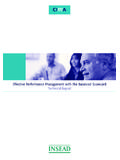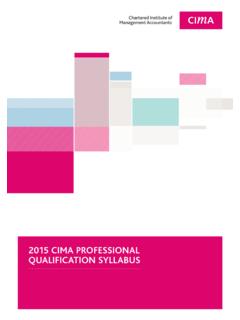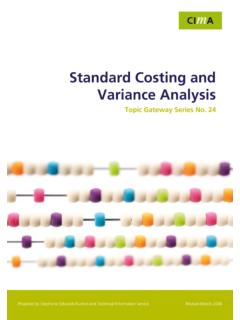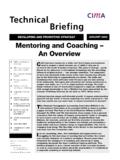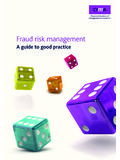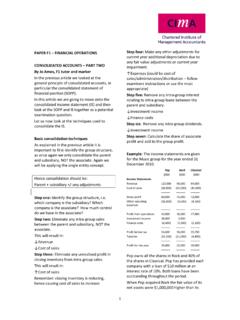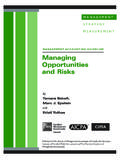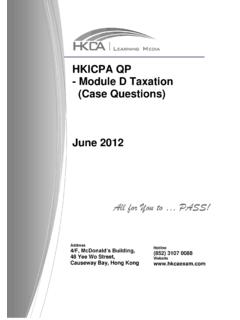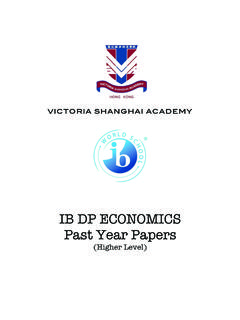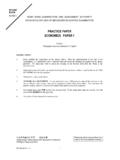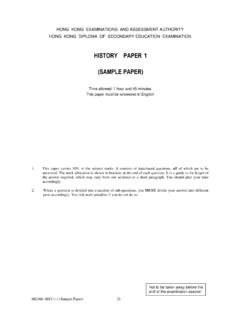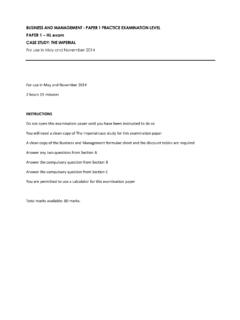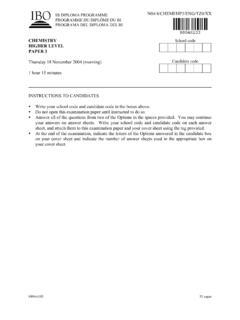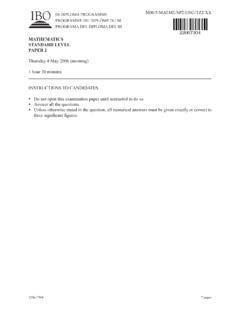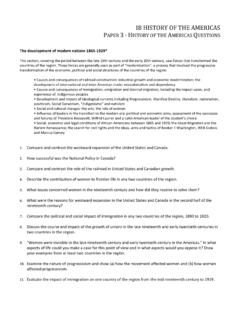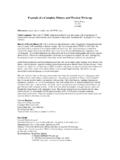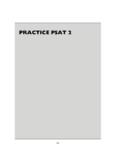Transcription of Performance Operations - CIMA
1 DO NOT OPEN THIS QUESTION paper UNTIL YOU ARE TOLD TO DO SO. The Chartered Institute of Management Accountants 2014 P1 Performance Operations Performance Pillar P1 Performance Operations 19 November 2014 Wednesday Morning Session Instructions to candidates You are allowed three hours to answer this question paper . You are allowed 20 minutes reading time before the examination begins during which you should read the question paper and, if you wish, highlight and/or make notes on the question paper . However, you will not be allowed, under any circumstances, to open the answer book and start writing or use your calculator during this reading time. You are strongly advised to carefully read ALL the question requirements before attempting the question concerned (that is all parts and/or sub-questions). ALL answers must be written in the answer book. Answers written on the question paper will not be submitted for marking.
2 You should show all workings as marks are available for the method you use. ALL QUESTIONS ARE COMPULSORY. Section A comprises 8 sub-questions and is on pages 2 to 5. Section B comprises 6 sub-questions and is on pages 6 to 9. Section C comprises 2 questions and is on pages 10 to 13. Maths tables and formulae are provided on pages 15 to 18. The list of verbs as published in the syllabus is given for reference on page 19. Write your candidate number, the paper number and examination subject title in the spaces provided on the front of the answer book. Also write your contact ID and name in the space provided in the right hand margin and seal to close. Tick the appropriate boxes on the front of the answer book to indicate which questions you have answered. TURN OVER Performance Operations 2 November 2014 SECTION A 20 MARKS [You are advised to spend no longer than 36 minutes on this question.]
3 ] ANSWER ALL EIGHT SUB-QUESTIONS IN THIS SECTION Instructions for answering Section A: The answers to the eight sub-questions in Section A should ALL be written in your answer book. Your answers should be clearly numbered with the sub-question number then ruled off, so that the markers know which sub-question you are answering. For multiple choice questions, you need only write the sub-question number and the letter of the answer option you have chosen. You do not need to start a new page for each sub-question. For sub-questions to you should show your workings as marks are available for the method you use to answer these sub-questions. Question One The economic order quantity is the order quantity which results in: A the lowest cost of ordering inventory. B the highest discount from suppliers. C the lowest combined total costs of ordering and holding inventory. D the lowest cost of holding inventory.
4 (2 marks) A decision maker using the maximin decision criterion will: A assume that uncertainty can be ignored and will select the option with the highest expected value. B assume that he/she will regret not having selected another option and will therefore minimise the possible regret under this assumption. C assume that the worst outcome will occur and will select the option that will give the highest return from the worst outcome possible under each option. D assume that the best outcome will occur and will select the option that will give the highest return from the best outcome possible under each option. (2 marks) November 2014 3 Performance Operations A company uses an activity based costing system. The company manufactures three products, details of which are given below: Product X Product Y Product Z Annual production (units) 160,000 200,000 100,000 Batch size (units) 100 50 25 Number of inspections per batch 3 4 6 Annual inspection costs are $150,000.
5 The inspection cost per unit of Product Y is closest to: A $ B $ C $ D $ (2 marks) A company uses a standard costing system. The company s sales budget for the latest period includes 1,500 units of a product with a selling price of $400 per unit. The product has a budgeted contribution to sales ratio of 30%. Actual sales for the period were 1,630 units at a selling price of $390 per unit. The actual contribution to sales ratio was 28%. The sales volume contribution variance for the product for the latest period is: A $15,600 F B $52,000 F C $14,560 F D $14,196 F (2 marks) A company s budget for the next period shows that it would breakeven at sales revenue of $800,000 and fixed costs of $320,000. The sales revenue needed to achieve a profit of $200,000 in the next period would be: A $1,000,000 B $1,300,000 C $1,320,000 D $866,667 (2 marks) TURN OVER Performance Operations 4 November 2014 A company s managers are considering investing in a project that has an expected life of five years.
6 The project is expected to generate a positive net present value of $240,000 when cash flows are discounted at 12% per annum. The project s expected cash flows include a cash inflow of $120,000 in each of the five years. No tax is payable on projects of this type. Required: Calculate the percentage decrease, to the nearest , in the annual cash inflow that would cause the managers to reject the project from a financial perspective. (2 marks) A company s sales revenue for the year just ended was $28 million. The company earned a gross margin of 40% on sales. All sales and purchases were on credit. The following balances have been extracted from the year end accounts: Inventory $4 million Accounts receivable $6 million Accounts payable $3 million Required: Calculate, to the nearest day, the company s cash operating cycle based on the year end figures. (4 marks) A company is preparing its annual budget and is estimating the number of units of Product W that it will sell in each quarter of year 2.
7 past experience has shown that the trend for sales of the product is represented by the following relationship: y = a + bx where: y = number of sales units in the quarter a = 15,000 b = 3,000 x = the quarter number where 1 = quarter 1 of year 1 Actual sales of Product W in year 1 were affected by seasonal variations and were as follows: Quarter 1: 20,250 units Quarter 2: 19,425 units Quarter 3: 25,200 units Quarter 4: 24,300 units Required: Calculate the expected unit sales of Product W for each quarter of year 2, after adjusting for seasonal variations using the multiplicative model. (4 marks) (Total for Section A = 20 marks) November 2014 5 Performance Operations Reminder All answers to Section A must be written in your answer book. Answers to Section A written on the question paper will not be submitted for marking. End of Section A. Section B begins on page 6 TURN OVER Performance Operations 6 November 2014 SECTION B 30 MARKS [You are advised to spend no longer than 9 minutes on each sub-question in this section.]
8 ] ANSWER ALL SIX SUB-QUESTIONS. YOU SHOULD SHOW YOUR WORKINGS AS MARKS ARE AVAILABLE FOR THE METHOD YOU USE. Question Two (a) A company, which operates from a number of different locations, uses a system of centralised purchasing. The directors of the company are considering whether to change to a system of decentralised purchasing. Required: Explain the benefits that may result from the company using a decentralised purchasing system. (5 marks) (b) A company has annual credit sales of $25 million. The company s credit terms are 30 days from the invoice date but the average settlement period for trade receivables is 60 days. The company is currently reviewing its credit policy. The credit controller has proposed a change to the company s credit policy as follows: (i) Implement stricter credit control procedures at a cost of $30,000 per year. and (ii) Offer customers a discount if they pay within 30 days.
9 It is estimated that, as a result of the proposed change to the credit policy, 60% of customers, by sales value, would pay at the end of the 30 day period. The remainder would take, on average, 50 days to pay. It is not anticipated that the change to the credit policy will result in a reduction in sales revenue. The company finances its trade receivables by a bank overdraft which has an interest rate of 14% per annum. Required: Calculate the net annual cost if the credit controller s proposed change to the credit policy is adopted. (5 marks) Section B continues on the opposite page November 2014 7 Performance Operations (c) FG is preparing its cash budgets for January, February and March. Budgeted data are as follows: November December January February March Sales (units) 750 800 800 850 900 Production (units) 800 800 850 900 950 Direct labour and variable overheads incurred $48,000 $48,000 $51,000 $54,000 $56,000 Fixed overheads incurred (excluding depreciation) $20,000 $20,000 $20,000 $20,000 $20,000 The selling price per unit is $200.
10 The purchase price per kg of raw material is $25. Each unit of finished product requires 2 kg of raw materials which are purchased on credit in the month before they are used in production. Suppliers of raw materials are paid one month after purchase. All sales are on credit. 80% of customers, by sales value, pay one month after sale and the remainder pay two months after sale. The direct labour cost, variable overheads and fixed overheads are paid in the month in which they are incurred. Machinery costing $100,000 will be delivered in February and paid for in March. Depreciation, including that on the new machinery, is as follows: Machinery and equipment $3,500 per month Motor vehicles $800 per month The opening cash balance at 1 January is estimated to be $15,000. Required: Prepare a cash budget for each of the three months January, February and March. (5 marks) TURN OVER Performance Operations 8 November 2014 (d) A company has surplus funds to invest for a period of three months.

